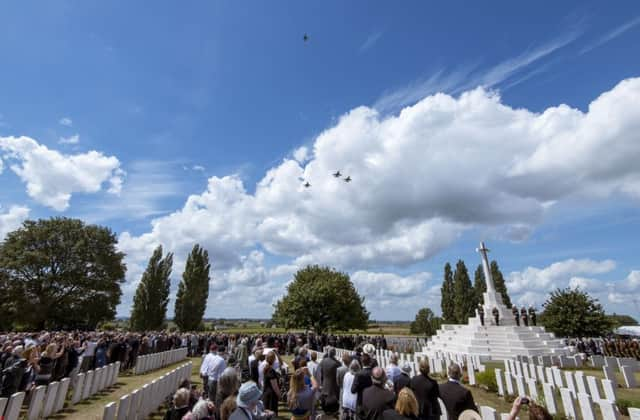A new generation weeps for horror of Passchendaele


Scattered clouds drifted over Ypres yesterday and the sunshine dappled the endless rows of white crosses, as two royal families and 4,000 ordinary ones gathered to remember the monumental sacrifice that had taken place there.
A century ago, it had been so different. With the worst rain for 30 summers and the drainage system shot to pieces, the land where the vast Tyne Cot cemetery now stands had been a quagmire.
Advertisement
Hide AdAdvertisement
Hide Ad“Nothing that has been written is more than the pale image of the abomination of those battlefields, and that no pen or brush has yet achieved the picture of that Armageddon in which so many of our men perished,” the war reporter, Philip Gibbs, had written in 1920.
His words were recalled yesterday by Prince Charles, who stood alongside the Duke and Duchess of Cambridge and the King and Queen of Belgium on the anniversary of the Third Battle of Ypres, the one the world would remember as Passchendaele.
Behind them at a sombre memorial stood the prime minister and some 4,000 descendants of those who fought.
“We remember it not only for the rain that fell, the mud that weighed down the living and swallowed the dead, but also for the courage and bravery of the men who fought here,” Charles said.
Advertisement
Hide AdAdvertisement
Hide AdMore than 100 days of fighting in the summer and autumn of 1917, starting on July 31, left more than half a million men dead or injured on both sides.
The Tyne Cot cemetery is the largest Commonwealth burial ground in the world, with 11,971 servicemen buried and remembered there - 8,373 of whom are unidentified.
Kate, dressed in a peach-coloured outfit, then joined Belgian Queen Mathilde and the German foreign minister, Sigmar Gabriel, in laying wreaths at the graves of four German soldiers.
The rows of headstones, each grave decorated with flowers, were “beautiful”, she said.
Advertisement
Hide AdAdvertisement
Hide AdMrs May, sombrely dressed, read a Bible passage from Ecclesiasticus.
The ceremony included singing and the Calling Of The Names, personal stories of some of the thousands of British and Commonwealth soldiers and others, including nurses and stretcher-bearers, at the battle.
They included an account by Private Bert Ferns, of the Lancashire Fusiliers, read by Fusilier Shaun Mclorie.
He wrote: “I staggered up the hill and then dropped over the slope into a sort of gully.
Advertisement
Hide AdAdvertisement
Hide Ad“It was here that I froze and became very frightened because a big shell had just burst and blown a group of lads to bits; there were bits of men all over the place, a terrible sight, men just blown to nothing. I just stood there. It was still and misty, and I could taste their blood in the air.”
The assembly also heard a letter written by a German soldier.
William completed the Calling Of The Names by reading that of the Unknown Soldier, saying he was “A soldier of the Great War, known unto God.”
Charles and King Philippe then led the laying of wreaths at the cross of remembrance.